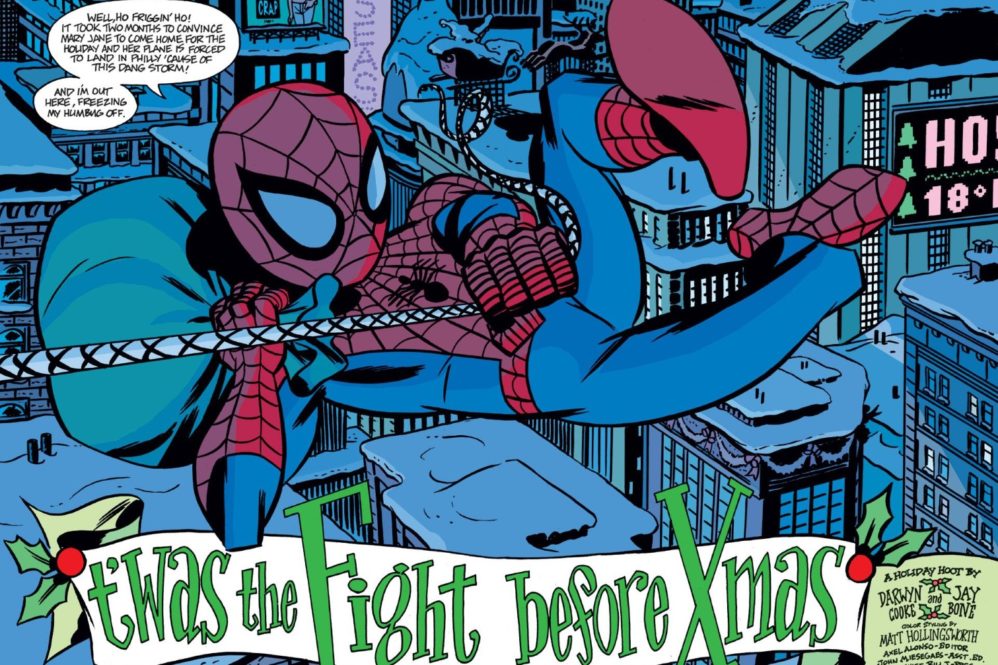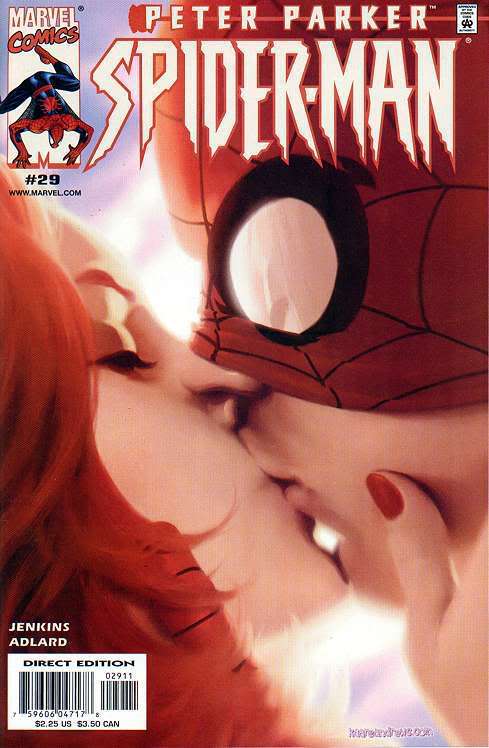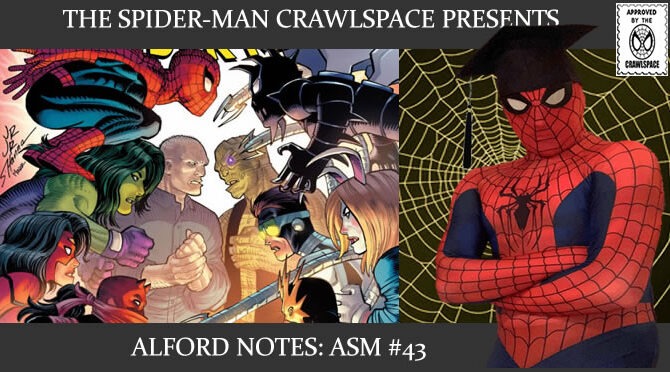I’ve been wanting to review Spider-Man runs that are currently under the radar, and since the column is called Tangled Webs, the Tangled Web anthology is a decent place to start. Last time, we went with the first eleven issues. Now we’re going with the second half.
Tangled Web #12: This largely forgotten story of Frogman from JM DeMatteis’ Marvel Team-Up/ Spectacular Spider-Man might actually have the most impact of any Tangled Web issue as it marks current Amazing Spider-Man writer Zeb Wells’ debut on the wallcrawler. It’s dense, so this is a single issue story in which a good amount happens. It is very specific, immediately showcasing how much it has to suck to be a teenager whose dad is a minor supervillain. The details are great, like a prank involving an effigy of Frogman. There are weird continuity issues, as Eugene has met Spidey before; there are some decent comics about that where he was just as ridiculous as his dad. So that is distracting, especially because it wouldn’t take much to take advantage of earlier continuity.
Artist Duncan Fegredo captures the middle-class suburban squalor pretty well. I can forgive the continuity problems, when a conversation with Spidey takes a fun turn. And it is a decent good-hearted story.
B+

Tangled Web #13: These issues show work from writers and artists who were sometimes already well-regarded, and sometimes would go on to become more popular. However, there were some flash in the pans, notably Ron Zimmerman, a TV writer known for regular appearances on the Howard Stern show. He came to comics with a gay take on Rawhide Kid, and followed that up with the Hollywood adventures of Kraven’s son. This standalone features some Spider-Man villains, including Al Kraven, chatting in a bar about encounters with the hero, structured on the Batman episode “Almost Got Him.”
It’s decent. Zimmerman and artist Sean Phillips get 38 pages, and they use it well to get a story that feels like a hangout movie. There are some artistic decisions I disagree with (Tombstone comes across like a wimp in order to make Kraven’s son seem tougher; How do Tombstone and Kraven have history if Kraven died before Tombstone’s first appearance?) but the main stories are okay enough. And there’s a twist with a civilian at the bar that ends up being a great moment for a major comics character, and puts everything else into perspective.
B+
Tangled Web #14: This issue might have the most famous writer, as Scott Levy AKA WCW’s Raven, focuses on what he knows best: the world of wrestling to show the events of Amazing Fantasy #15 from the point of view of Crusher Hogan. He was joined by co-writer Brian Azzarello, and artist Giuseppe Camuncoli, marking the Italian’s first of many Spider-Man projects. It is very specific about professional wrestling, specifically the minor-league wrestling overshadowed by the big corporations. There’s a type of story that’s been done a lot about someone from Spider-Man’s origin who is affected in some way by the events, and this is the best of those. We get a take on Crusher Hogan as a guy who understands the business and is going for something bold. Stylistically, it’s bold and interesting, a great example of the hooks of this series about how everyone is the protagonist in their own story. Until someone else shows up.
A-

Tangled Web # 15: Writer/ Artist Paul Pope has a story that’s a bit unusual in that it ends at a cliched expected moment, and might be better if there were more of it. The story of a teenage girl who is a fan of Spidey has some good moments, starting out well with very specific texture about a dysfunctional family. A super is up to something, and his daughter’s a fan of Spider-Man who gets to witness a fight between Spidey and a new supervillain. The details are nice, like some posters and souvenirs being hard to get a hold of. And then the story comes to a very obvious twist, and it just ends. This is technically well told, and if it was part one of a story that dealt with the aftermath of an emotionally devastating discovery, this could be a decent comic. But it doesn’t do that. Intellectually, I can acknowledge what it does well, but it’s just disappointing.
C
Tangled Web #16-17: There are a handful of writers who aren’t particularly well-regarded but there was a moment when they get some major projects, which briefly connected with editors and maybe even audiences. One of these is Daniel Way, who works with Leonardo Fernandez on a Tombstone VS D-listers prison drama. It’s got the Spot, Rocket Racer and the toughest guy in prison is the Kangaroo. It’s fine. I’m kinda sold on it with the opening where Tombstone is carted to a hospital after a mid-robbery heart attack, and a doctor is happy the feds want him. One problem is that I’m just not invested in the outcome. There’s no one likeable, and this isn’t exactly Tarantino level writing. If Tombstone is betrayed, why care?. There are some developments that are nasty and cynical, which seem tonally off, like spending time with a kid just learning he could curse for the first time. There’s some good stuff, but much of it is a mess.
C
Tangled Web #18: This might be the least-regarded Tangled Web issue, as writer/ artist Ted McKeever looks at one of the most obscure Spider-Man bad guys: Typeface from the Jenkins/ Buckingham Peter Parker Spider-Man, and gives him an archenemy in Spellcheck, a wannabe sidekick obsessed with grammatical pedantry. It’s quirky, but it’s fun, a decent showcase for McKeever.
B

Tangled Web #19: In this single issue story, Grizzly, depicted as he often is as a former bad guy who can’t get any respect, gets out of jail and Rhino keeps ruining his life. It’s the type of story that you see in bad movies, but it’s fine for a single issue comic book. Some of the indignities are clever, and there are some decent gags. The creative team is Robbie Morrison (2000AD, The Authority) and Jim Mahfood.
B
Tangled Web #20: The Jonah spotlight might just be my favorite story from the run, as well as my favorite J. Jonah Jameson story, and as far as I’m concerned, he’s the best supporting character from comics. It starts with “Bring your child to work” day at the Daily Bugle, an event that goes quite badly for Jonah (as it should) which leads to mandated conversations with a psychiatrist about his anger issues. Wells immediately gets Jonah’s voice, showing a guy who goes too far, but who can be perceptive (his answers to questions to piss off a psychiatrist are great) and who has some depth. Dean Haspiel’s exxagerated style works to keep a conversation interesting, balancing humor and pathos. There is a lovely scene about the moment Jonah fell in love with his wife, and a plausible theory that fit the continuity to date (parts of this issue had to be retconned when J Jonah Jameson Sr became a supporting character although the effort to keep this story canon is a testament to its quality) about why Jonah hates Spider-Man so much.
A+
Tangled Web #21: I went into more depth about this one in a column on Darwyn Cooke. It’s not on the level of his Valentines Day story, but it is a joy to read. I really wish Cooke had done at least one more Spidey comic because it would make for a fantastic TPB. One thing I appreciated in this re-read is just how quickly and efficiently the situation is set-up, so we can get to the Christmas blizzard fun.
B+

Tangled Web #22: This issue might include the most obscure creative team on the anthology. I had to google writer Brian Patrick Walsh to learn that a year later he did a mini-series called Witches for Marvel and that’s all I could learn. Artist Alberto Dose was a bit better known, with an arc of Geoff Johns’ Flash and some crime comics for IDW. What matters is that they did work to be proud of, in a story about a police investigation complicated by Spider-Man’s involvement, as two guys literally caught in Spider-Man’s web after a crime had enough time to get their story straight, and claim that it was a misunderstanding. This is a mature take on police work. The cops are not perfect, but they want to bring the suspects to justice. There’s a ticking clock as a lawyer will likely be able to shut down the interrogation, so they’re desperate fro a confession. And there are some decent twists, suggesting that Spider-Man, a largely off-panel presence, knows a little bit more about what’s going on. Dose’s noir style art is a great fit, and reminds me a lot of fellow Argentine Eduardo Risso.
A
There are two other stories that Marvel published at around the same time that are worth covering.
Sweet Charity: I’m not sure why this Zimmerman and Darick Robertson double-sized one-shot wasn’t released in Tangled Web. I’ve always associated this story with the anthology, even if it is very much its own thing. Zimmerman wrote two god-awful Spider-Man comics at the same time; a Jay Leno team up that was an unnecessary extra in multiple Marvel comics, and a worse mini-series about Kraven’s son going into Hollywood, but this was pretty decent so he leaves the wall-crawler with a 50/50 average. It’s 50+ pages which allows a newcomer to comics to play around with the format. He can spend five pages on a Daily Bugle discussion. The main thing about a longer page count is whether the results are interesting, and generally it is. The basic idea is that Spider-Man & Jonah agree to go camping as part of a post-9/11 charity event. Spidey’s out of his element, forced to spend a weekend with someone he hates. There are few things in comics as satisfying as Jonah and Spider-Man hating one another, and this works, building on earlier continuity, and gets in some good points for both of them. Not every joke lands, but it’s well worth the two bucks it goes for on mycomicshop.
A-

Peter Parker Spider-Man #42-43: This Zeb Wells/ Jim Mahood two-parter has been included in some collections of Tangled Web, although it wasn’t in the giant-sized omnibus edition. It does unite a writer and artist who worked on separate Tangled Web issues in the fourth TPB volume, so I get why it was collected there. It is aesthetically a better fit for Tangled Web, matching the wall-crawler with an indie artist while telling a contemporary self-contained story with new characters who provide an entry point to readers. It does connect to an earlier story in Paul Jenkins’ run of Peter Parker Spider-Man, as the Sandman makes a return after his apparent death. Within a year, Wells would take over the title for seven issues, before it’s replaced by Jenkins/ Ramos’ Spectacular Spider-Man run.
The material is all over the place, with parodies of early 2000s MTV, and the reality TV and pop music it covered. Wells gets in some pretty decent jokes and scenes with unexpected pathos, like when Sandman is trying to remember his life and recalls a romance that went bad. Wells captures Spider-Man’s voice pretty well, responding to an absurd situation. The story fits cartoonist Jim Mahfood’s style, which is obviously not standard superhero fare, but appropriate for a Mad Magazine style parody with an oddball villain like Sandman.
B
It did seem that a few months into the second year, that there was a bit of a diminishing returns with the title. The cardstock covers and glossy paper likely made for an expensive publication, which also had low sales. But it did provide some accessible Spider-Man stories, which was useful for Marvel at a time when the first movie was coming out. After 22 issues and four TPBs, it likely served its purpose. If anything, Marvel might’ve recognized that fans looking for standalone stories preferred mini-series (which are much easier to sell as trades), with the Jeph Loeb/ Tim Sale Spider-Man: Blue coming out at the same time, and proving to be a perennial seller. In the next few months, the company would publish a Marvel Knights Spider-Man/ Wolverine mini-series by TV writer Brett Matthews and Vatche Mavlian (I didn’t care for it that much) and a Doctor Octopus mini-series by Brian K Vaughan and Staz Johnson (I remember this one being quite good.) Several of those mini-series would be written by Zeb Wells, a possible topic for a future entry.
I would rate the entire run as an “A.” There is some really good material, even if Wizard gave it a B-. The stories aren’t for everyone, especially given the stylistic variety, but it’s a good mix of indy sensibilities with Spider-Man’s world.
What did you guys think of it, and was there any story that left an impression on you?










I like that a lot, Thanks for that one, Thomas.
Cheers.
Thank you for this. Tangled web as a run is a little known gem that deserves way more attention.
I really wish marvel would publish something like that once again. Mostly self contained issues that show the impact that spiderman has on his world.
#13 is a good story with a great ending that doesn’t make any sense the more you think about it. But man, that ending!
Was the Tombstone story in #16-17 the one where he was in prison and Kangaroo got stuck in a vent, with the lower half of his body hanging out, and it was implied that the inmates who found him there did … um … they took … uh … *you know*.
I’m not making this up! I swear this happened in a Spider-Man book!